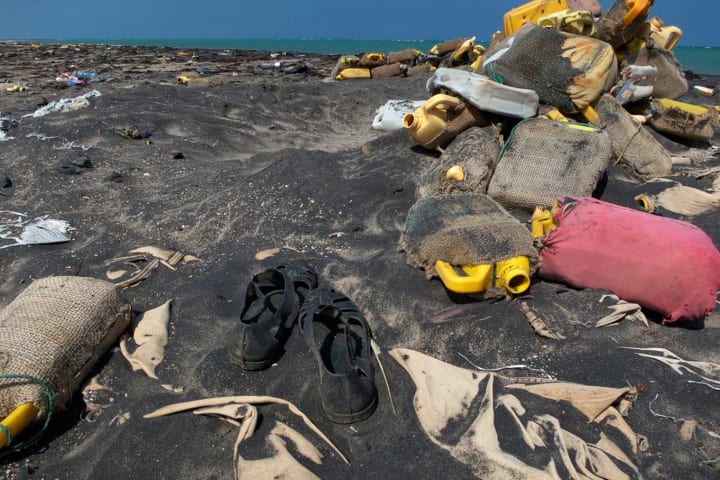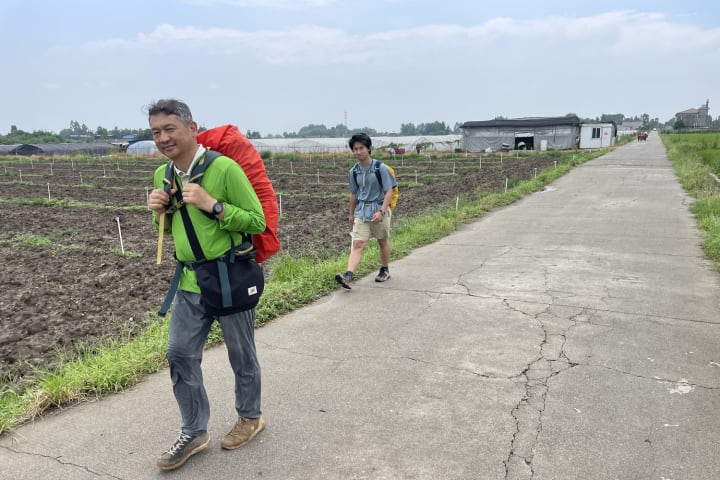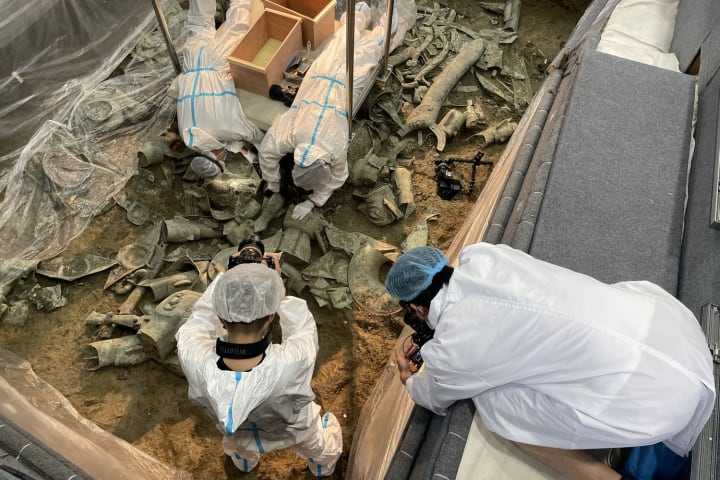IDEA SET
IDEA SET
Exploring Human Migration with the Out of Eden Walk
Exploring Human Migration with the Out of Eden Walk
Explore diverse stories of modern human migration with National Geographic Explorer and journalist Paul Salopek. Analyze stories of migrants from around the world and challenge students to identify stories from their own communities.
Grades
4 - 12
Subjects
English Language Arts, Social Studies, Anthropology, Storytelling

National Geographic Explorer Paul Salopek is walking 24,000 miles across the planet, following the path of early human migration from East Africa to South America and capturing local stories as he travels. This slow journey across the Earth, which he calls the Out of Eden Walk, gives him a human perspective on the major stories of our time. You can introduce students to Paul’s walk with this short video and access all of the stories from Paul and his walking partners here.
This idea set provides tools to examine stories about human migration from the Out of Eden Walk with students. It is one of a series of Idea Sets exploring important ideas and themes addressed by stories from the Out of Eden Walk. In each of these Idea Sets you will find resources from the walk along with classroom activities and learning tools to support your exploration of these concepts with your students.
This idea set is part of a collection called Out of Eden 10th Anniversary: Human Migration.

Building Background Knowledge: Human Migration
Before exploring articles from the Out of Eden Walk, take some time to activate prior knowledge and build background knowledge on human migration. Introduce your students to key ideas about human migration with a quick-write on the question:
- What causes people to leave home? Why do people move to a new place? What are some things that may happen when they move there?
Ask students to pair-share, comparing their answers and finding similarities and differences.
Use the Key Concepts tool to have students define and provide examples of important ideas and terms that they will encounter as they discuss the Out of Eden Walk materials. Terms could include:
- Migration
- Refugee
- Push Factor
- Pull Factor
- Cultural Diffusion

Stories of Human Migration from the Out of Eden Walk
Paul Salopek, his walking partners, and other collaborators have collected many stories of migration along the Out of Eden Walk. The following stories show some of the different perspectives on migration they have encountered.
The articles, regular dispatches that Paul writes throughout the journey, are available at fifth- and eighth-grade reading levels, as well as in their original form. There are also multimedia resources from the walk: “milestones” are snapshots Paul records every 100 miles on the trek. These contain videos, panoramic photographs, and brief interviews with the first person he encounters at each location. Walking tours include interactive maps with photos and narration that guide readers through key locations along the route. Consider assigning different articles to groups of students in your class for analysis and discussion. Students can also locate the regions Paul and his walking partners visit using National Geographic Mapmaker. Other cooperative learning activities such as stations and jigsaw would also work well for exploring these resources (more specific activities and tools are included in the next section).
- The Things They Leave Behind: (article) Migrant workers, refugees, and deserters travel through the Rift Valley to reach Yemen, Saudi Arabia, and other countries. The harsh desert path is exhausting and dangerous.
- Tomatoes: (article) Paul visits with refugees from the Syrian war in Jordan, who work as tomato pickers. They share stories of their journey and the homes they left behind.
- Displaced: (milestone) In this multimedia milestone, we see the tents of refugees from Syria who are living in Jordan and picking tomatoes.
- Walking Through a Youthful Exodus in India: (article) In the Punjab region of Northern India, numerous young people are taking English lessons. Many are leaving the area to seek opportunities in countries such as Australia and the United Kingdom.
- Walking Kolata: (walking tour) In this virtual walking tour, Paul’s walk takes him through neighborhoods in Kolkata, a major city in eastern India. Paul encounters current migrants living in the city and evidence of migrations from the city’s long history.
- Walking the World for 10 Years, a Storyteller Ponders the Upsides of Nomadism in an Age of Drastic Change: (article) Paul details the global importance and benefits of migration, despite the poor treatment many often experience in their new homes.
- On the Walking Trail, a Young Man Ponders His Divided Identity: (article) A young man who grew up in China and the United States reflects upon how his upbringing shaped his identity.
- Adjusting to New Lives, Kids Bond over Stories of Home and Hope: (lab talk) Through the HomeStories project, immigrant families from various countries come together to share stories about home and adjusting to life in the United States. They answer the same three questions that Paul asks the first person he sees every hundred miles on his journey. Note: This is the original article; text is not leveled. You can also access the Homestories project here.
- Leaving the Farm: In this chapter of the Out of Eden Walk podcast, Paul Salopek and walking partner Arati Kumar-Rao recall meeting young people in Punjab, India who planned to seek their futures far from home.

Exploring Human Migration with the Out of Eden Walk
As your students explore the Out of Eden Walk, use the Learning Tools below to look more closely at what these stories can reveal about human migration.
- Use the See, Think, Wonder Learning Tool with the “Displaced” milestone, a location from the “Walking Kolkata” walking tour, or a striking image from one of the articles. You may want to assign different images to different student groups, then have groups share. Collect student questions and categorize them to identify topics for more exploration.
- Break students into small groups, assigning each group an article to read - or a podcast segment to listen to - and discuss. Have students use the Save the Last Word for Me discussion protocol from the Conducting Powerful Conversations Learning Tool to examine the resource closely. As they read or listen, ask them to choose their passage based on what it shows about how humans experience migration.
- Conduct a structured group discussion with your students to analyze the links between stories. Use the Socratic Seminar format from the Conducting Powerful Conversations Learning Tool to help students think critically about and make connections between the varied stories of human migration from the Out of Eden Walk and other resources you may be using in your classroom. Use the guiding questions below to begin the discussion. Encourage students to speak to each other and use examples from their texts:
- What was the most surprising thing you learned from these stories? Why did that surprise you?
- What are some of the similarities between the stories of migration we have seen? What are some of the differences?
- How would you describe the role push factors play in these stories? How would you describe the role of pull factors?
- How have the stories of migrants in the Out of Eden Walk changed the way you think about migration in our community? Why has this changed?
You may want to “fishbowl” your classroom discussions to allow smaller groups to discuss while the larger group observes. See the Learning Tool for more details on this practice.

Extensions: Exploring Human Migration in Your Community
Let your students become Explorers! Connect the stories of human migration from Out of Eden Walk to stories of human migration in your own community.
- Work together as a class to develop a set of interview questions that students want to ask about a migrant’s journey moving from one location to another. Consider the questions that arose in earlier activities and the questions asked in the Out of Eden Walk milestones and the HomeStories project. Use the Oral Storytelling: Interviews Tipsheet to help students interview people in their lives who have moved and discover how it changed them and their community.
- Create a walking tour of your community with stops that highlight the ways human migration has shaped the world around you. Use National Geographic Mapmaker to print a map of your community and chart a walk with several key stops.
- Select a subtopic of interest to research from one of the Out of Eden articles on human migration (e.g. tomato farming in Syria, Punjabi culture, or the Syrian refugee crisis). Individuals or groups of students can create mini slideshow presentations to share more information on these subtopics.
- Read stories from the Out of Eden Walk HomeStories project and select three to four stories related to human migration to explore more deeply. Encourage students to choose from a variety of regions using the HomeStories map. They can use thinking maps to compare and contrast the various stories with regards to human migration, identifying similarities and differences among the responses. In small groups, students can share their reflections on the HomeStories they selected. Students can also create their own HomeStories as a possible home extension (requires an original photo).
Media Credits
The audio, illustrations, photos, and videos are credited beneath the media asset, except for promotional images, which generally link to another page that contains the media credit. The Rights Holder for media is the person or group credited.
Editor
Text Levels
Web Producer
Instructional Designer
With help froms
Last Updated
September 4, 2024
For information on user permissions, please read our Terms of Service. If you have questions about how to cite anything on our website in your project or classroom presentation, please contact your teacher. They will best know the preferred format. When you reach out to them, you will need the page title, URL, and the date you accessed the resource.
Media
If a media asset is downloadable, a download button appears in the corner of the media viewer. If no button appears, you cannot download or save the media.
Text
Text on this page is printable and can be used according to our Terms of Service.
Interactives
Any interactives on this page can only be played while you are visiting our website. You cannot download interactives.